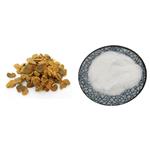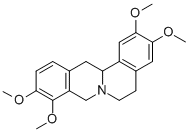Rotundine: overview and effects on the central nervous system
Feb 2,2024
General Description
Rotundine is a tetrahydroprotoberberine diisoquinoline alkaloid found in herbal plants. Unlike its counterpart d-THP, Rotundine possesses central analgesia, sedation, and stability effects. It has been utilized effectively in traditional Chinese medicine for over 40 years and has demonstrated remarkable effects in combating drug addiction and neurotoxicity. Rotundine exhibits various pharmacological effects on the heart and brain, including cardioprotection and neuroprotection. Research has shown that Rotundine primarily affects the concentration of dopamine in the brain through its interactions with the dopaminergic system, resulting in reduced addictive behavior and counteracting the rewarding effects of drugs. Its effects on calcium-sensitive receptors suggest potential therapeutic applications in preventing neurotoxicity.

Figure 1. Rotundine
Overview
Rotundine, short for l-enantiomer tetrahydroprotoberberine, is a primary active constituent found in herbal plants such as Stephania rotunda Lour and Corydalisambigua. It is a tetrahydroprotoberberine diisoquinoline alkaloid with molecular weight 355.43. Unlike its counterpart d-THP, Rotundine has been found to possess central analgesia, sedation, and stability effects. Research has shown that Rotundine is capable of providing pain relief and sedation, while d-THP lacks these properties and may even lead to toxicity when present in drug preparations or racemic mixtures. Rotundine has been widely used as an active ingredient in traditional Chinese herbal preparations for over 40 years. It was the first nerve system drug derived from traditional Chinese medicine and has demonstrated remarkable effects in combating drug addiction and neurotoxicity. Additionally, Rotundine exhibits various pharmacological effects on the heart and brain, including cardioprotection, neuroprotection, anti-oxidation, anti-apoptosis, anti-infection, and anti-inflammatory effects. Studies have indicated that Rotundine can improve memory impairment, protect the blood-brain barrier, and mitigate cerebral ischemia reperfusion injury. Furthermore, it has shown potential in reducing drug cravings and withdrawal symptoms caused by heroin, as well as decreasing cocaine self-administration and drug-seeking behavior in rats. These findings suggest that Rotundine may hold promise in the treatment of drug dependence and addiction. In summary, Rotundine is a significant compound obtained from herbal plants and has been utilized effectively in traditional Chinese medicine for its analgesic, sedative, and therapeutic properties. Its diverse pharmacological effects make it a promising candidate for various medical applications. 1
Effects on the central nervous system
Neurotransmitter receptors
Rotundine has been extensively studied for its effects on neurotransmitter receptors and its potential therapeutic applications. Neurotransmitters are crucial for the regulation of the nervous system, and the effects of Rotundine on these neurotransmitters form the basis of its neuropharmacology. One important neurotransmitter affected by Rotundine is dopamine (DA), which plays a significant role in drug dependence. Research has shown that Rotundine acts as a DA receptor blocker, specifically targeting the DA1 and DA2 receptors with high affinity. This distinguishes Rotundine from other common DA receptor antagonist drugs like Haloperidol. Additionally, Rotundine binds to DA3 receptors, albeit with a lower affinity than DA1 and DA2 receptors. The sedative and anti-anxiety effects of Rotundine might be attributed to its action on the GABA (A) binding site. While much of the research on Rotundine has focused on its effects on the DA system in the brain, there is also evidence suggesting its involvement in the calcium ion/calcium-sensitive receptor pathway in myocardium and lung endothelial cells. Studies have demonstrated that Rotundine has protective properties against methamphetamine (METH) abuse, reducing spatial memory impairment and addictive behavior associated with METH. The mechanisms underlying METH-induced neurotoxicity involve increased neuronal firing rate, dysregulation of mitochondrial function, oxidative stress, and increased intracellular calcium ion concentrations. Rotundine has been shown to inhibit oxidative stress, calcium channels, and Ca2+ overload, suggesting it may modulate addictive behavior and neurotoxicity induced by METH through these mechanisms. In summary, Rotundine influences various neurotransmitter receptors, particularly DA receptors, and interacts with other receptors involved in the regulation of anxiety and sedation. 2
Effects on neurotransmitter content
Existing research has demonstrated that Rotundine does not significantly affect the levels of the main monoamine neurotransmitters, such as serotonin (5-HT) and noradrenaline (NA), in the rat brain stems. However, Rotundine has been found to have a notable impact on the concentration of dopamine (DA) in the brain. It acts as a blocker of the dopaminergic DA2 receptor and a calcium ion (Ca2+) antagonist. By blocking the DA2 receptor, Rotundine can reduce the addictive effects of morphine. Additionally, it counteracts the rewarding effects of morphine by inhibiting Ca2+ activity and reducing the level of nitric oxide (NO). Studies have shown that Rotundine can bind to calcium-sensitive receptors and inhibit Ca2+ activity. Furthermore, Rotundine has been found to protect against pulmonary endothelial cell apoptosis by inhibiting the calcium-sensitive receptor/PLC-γ pathway and its effect on Ca2+. However, further research is required to determine whether Rotundine can prevent METH-induced neurotoxicity by inhibiting Ca2+ activity. In summary, Rotundine primarily affects the concentration of dopamine in the brain through its interactions with the dopaminergic system. It acts as a blocker of the DA2 receptor and a calcium antagonist, resulting in reduced addictive behavior and counteracting the rewarding effects of drugs. Its effects on calcium-sensitive receptors and Ca2+ activity suggest potential therapeutic applications in preventing neurotoxicity. 2
Reference
1. Wang JB, Mantsch JR. l-tetrahydropalamatine: a potential new medication for the treatment of cocaine addiction. Future Med Chem. 2012;4(2):177-186.
2. Liu L, Liu M, Zhao W, Zhao YL, Wang Y. Levo-tetrahydropalmatine: A new potential medication for methamphetamine addiction and neurotoxicity. Exp Neurol. 2021;344:113809.
- Related articles
- Related Qustion
- Rotundine: Indication, Pharmacodynamics, Mechanism of action,Toxicity, Preparation Mar 20, 2023
The Rotundine (C21H25NO4), also known as fumarate, that is, l-tetrahydropalmatine (l-THP), is an alkaloid extracted from the dried alkyne stem of the W.T.Wang of the poppy plant Corydalis yanhusuo.
Succinonitrile is a colourless to light brown crystalline or colourless waxy solid compound. It is highly toxic and is commonly used in materials chemistry or engineering technology to make plastics and nitrocellulose fibres.....
Feb 1,2024Organic ChemistryPhenylmethylsulfonyl fluoride is a hazardous inhibitor used in experiments to stabilize protein samples, posing health risks if mishandled.....
Feb 2,2024APIRotundine
10097-84-4You may like
- Rotundine
-

- $0.00 / 1KG
- 2024-06-03
- CAS:10097-84-4
- Min. Order: 1KG
- Purity: ≥98% HPLC
- Supply Ability: 1000KG
- Rotundine
-

- $0.00 / 1kg
- 2024-05-30
- CAS:10097-84-4
- Min. Order: 0.10000000149011612kg
- Purity: ≥99%
- Supply Ability: 20tons
- Tetrahydro palmatine
-

- $100.00 / 1kg
- 2024-04-25
- CAS:10097-84-4
- Min. Order: 1kg
- Purity: >99%
- Supply Ability: 20tons





